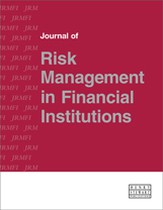Market BuVaR: A countercyclical risk metric
Abstract
The malfunction of the value-at-risk (VaR) model during the 2008 credit crisis was a key risk management failure. This metric is now criticised for being too little, too late. An improvement is proposed — making VaR countercyclical and more robust to fat tails. The new metric is called bubble-VaR (BuVaR), the expected shortfall of a trading book portfolio with the effects of procyclicality removed. It involves inflating one side of the return distribution of an asset by a scaling factor called bubble that depends on the location of the present state in the boom-bust cycle. In a boom cycle, the negative side of the distribution is inflated, in a bust cycle, the positive side is inflated. Compared to VaR, BuVaR is countercyclical (it leads crashes), distinguishes between long and short positions (is asymmetrical) and provides an additional buffer for fat tails by recognising that crashes can happen only in the counter-trend direction. Thus, this method is useful for the purpose of a countercyclical capital buffer for market risk. The approach relaxes the VaR assumptions of independent and identically distributed (i.i.d.), and stationarity of variables. It postulates that the empirical phenomena of fat tails, skewness, volatility clustering and the leverage effect can be better understood by modelling the noise and cycle components together, instead of just the noise of the time series as modelled in VaR.
The full article is available to subscribers to the journal.
Author's Biography
Max Wong is the Head of VaR Model Testing at a UK bank and has 15 years of experience in the financial services industry. He has recently published a book entitled: ‘Bubble value at risk: Extremistan and Procyclicality’ (Immanuel Consulting, 2011). Prior to this, Max has worked in other roles such as market strategist, futures trader and financial analyst at various financial institutions. He was an ‘open outcry’ pit trader during the Asian crisis in 1997 and a quantity risk manager during the credit crisis in 2007. Max holds a BSc degree in physics and an MSc degree in financial engineering. His current research is in the area of financial regulatory reform and innovative risk management.
Citation
Wong, Max (2011, September 1). Market BuVaR: A countercyclical risk metric. In the Journal of Risk Management in Financial Institutions, Volume 4, Issue 4. https://doi.org/10.69554/SFUZ4164.Publications LLP
